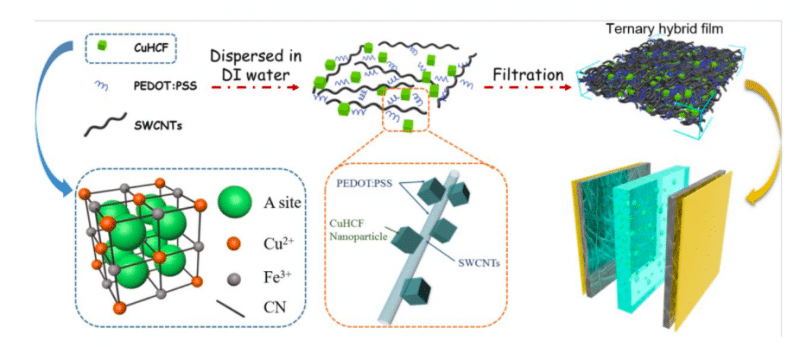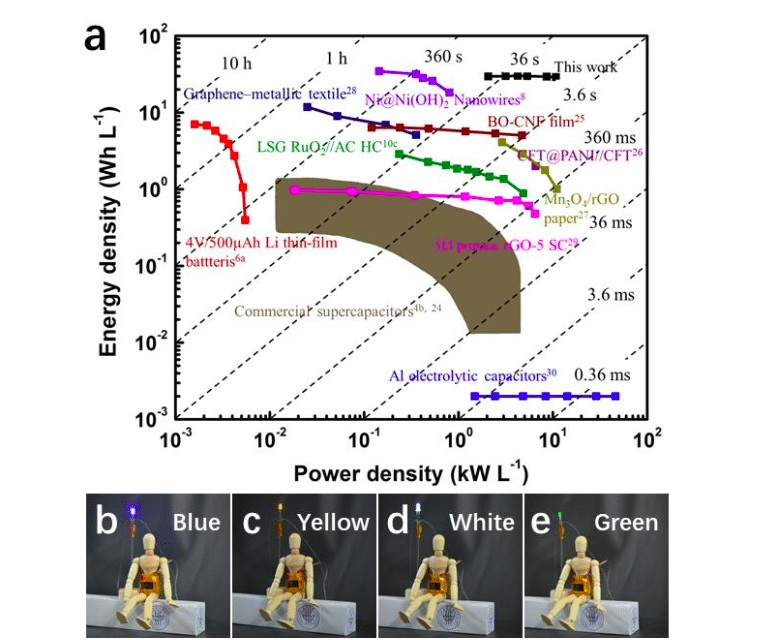
Recently, lightweight, flexible, and high electrochemical performance energy storage devices are crucially needed, due to the increasing demand for various wearable and portable electronics, such as multifunctional sensors and artificial skins.

Republished with permission from Elsevier from https://doi.org/10.1016/j.jpowsour.2018.03.046.
Because of its promising performance, such as high power density, excellent reversibility, long cycle life, and ultrafast charge-discharge rate, the supercapacitor has attracted a great deal of interest all over the world in both the industrial and academic communities. What’s more, it’s easier for supercapacitors to achieve flexibility safely in contrast with batteries, which makes supercapacitors more promising for flexible electronics.
However, low energy density, which is one of the biggest drawbacks of supercapacitors, hinders the development of their applications. Fortunately, a pseudo-capacitor based on the pseudocapacitance process, which is a faradaic process what involves surface or near-surface redox reactions, provides the possibility to achieve high energy density at high charge-discharge rates.
Most recently, more and more researchers have adopted the view that high volumetric capacitance is vital to the development of flexible devices with compared to mass and area (4, 26-27). In other words, we need an energy storage device which can provide as much energy as possible in a rather limited space, and energy can be charged into it as fast as we can. So far, many free-standing electrodes have been fabricated through chemical deposition (28), hydrothermal (14), or mechanical mixing (29) of pseudocapacitive species with carbon materials, such as 1D carbon nanotubes (30-32) and 2D graphene (2-3). These electrodes are generally given high ionic conductive materials that can provide pathways for rapid ion diffusion and electron transport.
In this work, a free-standing single-walled carbon nanotubes (SWCNTs)/poly(3,4-ethylenedioxythiophene) polystyrene sulfonate (PEDOT:PSS) / Copper Hexacyanoferrate nanoparticles (CuHCF NPs) hybrid film was fabricated by a simple filtration approach. The resulting 3D interconnected films exhibit a combination of the desired properties, such as good electrical conductivity (1.5*103 S cm-1), high bulk density (1.69 g cm-3), and extremely high performance (969.8 mF cm-2 and 775.2 F cm-3 at a scan rate of 5 mV s-1) in supercapacitors.
To get such a good performance, these three units played different roles in this film: (1) SWCNTs crossed with each other to create an interconnected 3D structure, which worked as a current collector because of the high conductivity of SWCNTs as well as the provided Electrical Double-Layer capacitance (EDLC) during the energy storage process. (2) PEDOT:PSS, a kind of conductive polymer, was used as a surfactant to help SWCNTs disperse well in water, as a binder to attach CuHCF NPs onto SWCNTs and make the film compact, and as a modifying agent to make the film more hydrophilic to reduce the ionic transport resistance. That’s why the prepared electrode had a very good performance rate. (3) The pseudocapacitive CuHCF NPs are decorated onto the SWCNTs/PEDOT:PSS networks and filled in interspace to enhance capacitances. These nanoparticles filled into the interspace of SWCNTs can increase the mass loading of the film without increase its thickness to obtain a high packing density.
At last, an asymmetric supercapacitor was assembled by using the SWCNTs/PEDOT:PSS/CuHCF film as a positive electrode and Mo-doped WO3/SWCNTs film as a negative electrode. This flexible supercapacitor exhibited a high energy density of 30.08 Wh L-1 with a power density of 4.25 kW L-1 based on the total volume of the device. The approach unveiled in this study could provide important insights to improving the volumetric performance of energy storage devices and help to reach the critical targets for high rate and high power density demand applications.

Figure 1. (a) Ragone plot of the volumetric power density versus energy density for the asymmetric supercapacitors compared to other devices, (b~e) the digital images of LED lights with different colors powered by 2 bent asymmetric supercapacitors in series. Republished with permission from Elsevier from https://doi.org/10.1016/j.jpowsour.2018.03.046.
This work is described in the article entitled A single-walled carbon nanotubes/poly (3, 4-ethylenedioxythiophene)-poly (styrenesulfonate)/copper hexacyanoferrate hybrid film for high-volumetric performance flexible supercapacitors, recently published in the Journal of Power Sources. This work was conducted by Jianmin Li, Haizeng Li, Jiahui Li, Guiqing Wu, Yaogang Li, Qinghong Zhang and Hongzhi Wang from Donghua University and Yuanlong Shao from Cambridge University.








